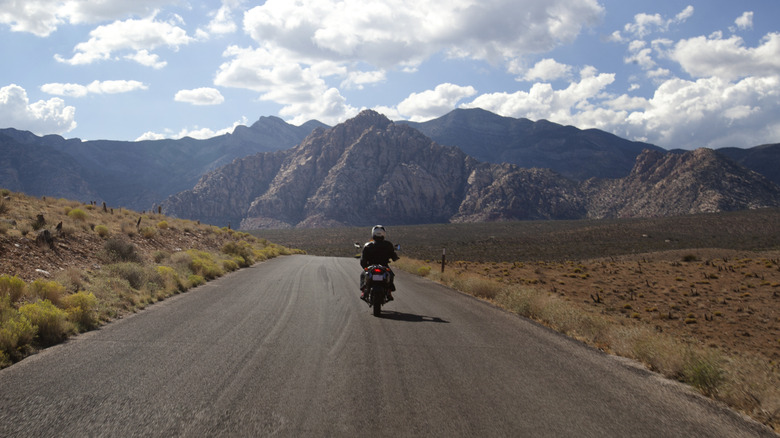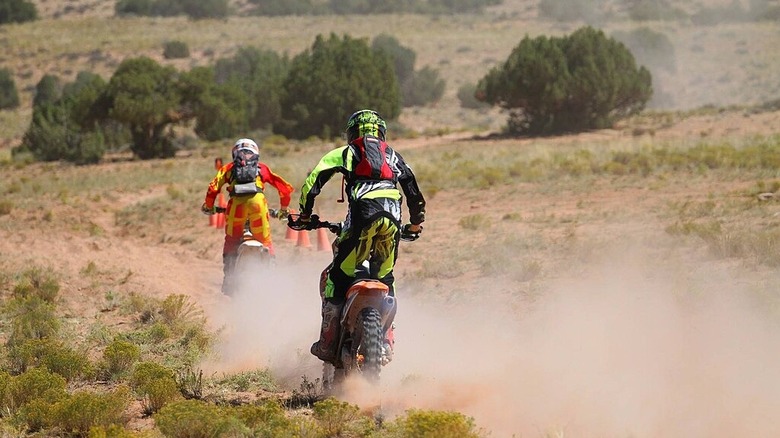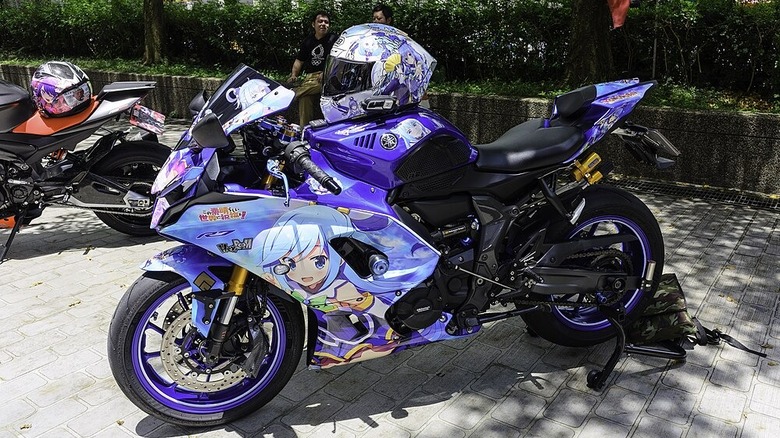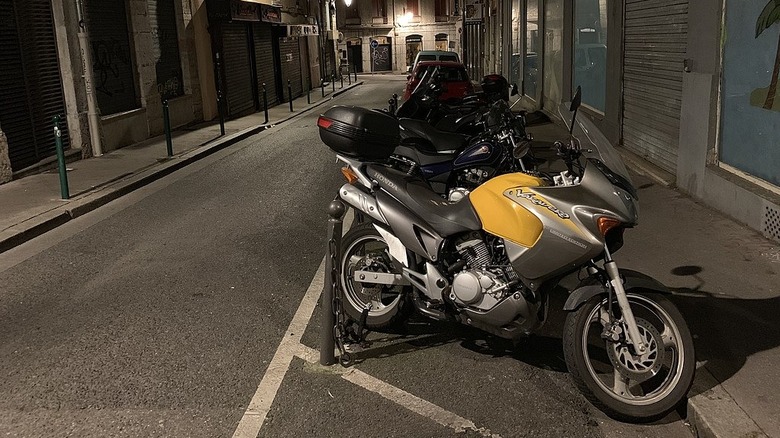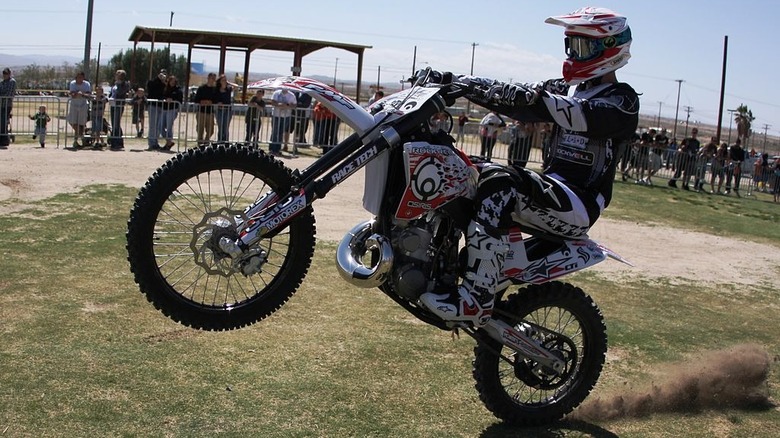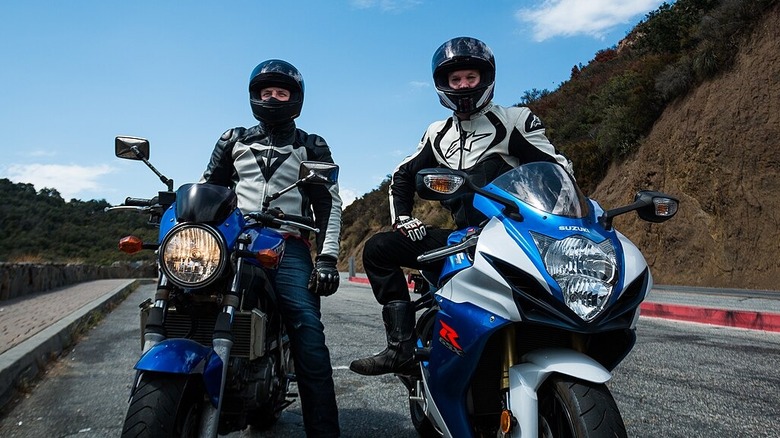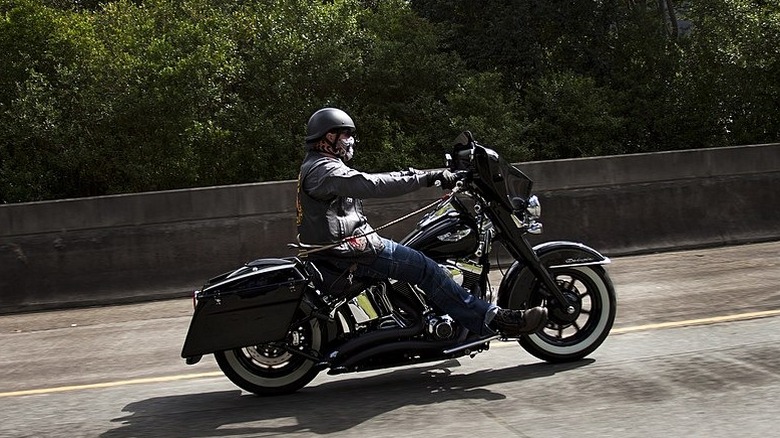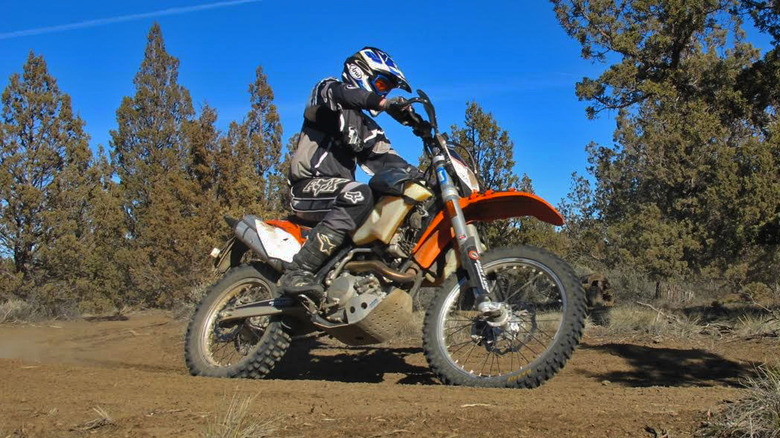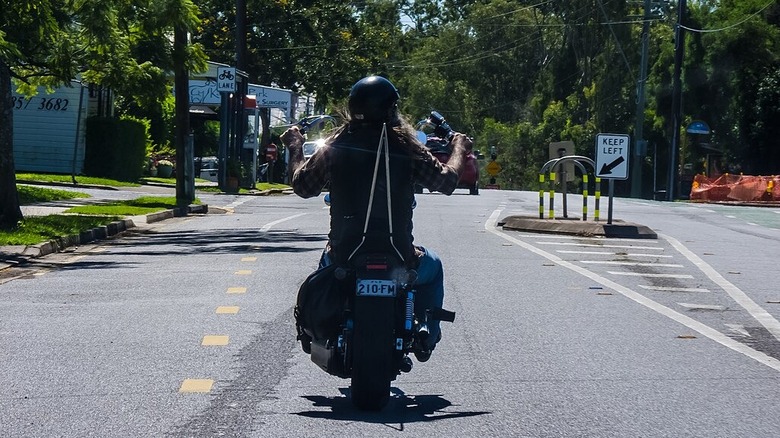11 Of The Weirdest Motorcycle Laws You'll Find In The United States
You might think that riding a motorcycle is a fairly simple thing to do. You get a motorcycle license, grab some safety gear, and take off, right? Yet, as it turns out, there is far more to riding a motorcycle, both in terms of preparing for your first ride and knowing what to expect, legally speaking.
While it's a good idea to take a motorcycle safety course in your state, there are some things you won't learn in a classroom or on a training bike. That includes some weird laws that motorcyclists should really be aware of. Most of them won't result in time behind bars, but it could be that your particular bike isn't permitted in some states or that wearing the wrong gear can get you pulled over across state lines.
The United States already has some strange driving laws, but motorcycles are also susceptible to offbeat restrictions, depending on the state. Not every place is as motorcycle-friendly as the next, and in some states, oddly limiting restrictions are part of the law. From outlawing certain types of motorcycles to restricting riders' attire while behind the handlebars, some states seem to have it out for motorcyclists.
Here are some of the weirdest motorcycle laws in the United States and what to know when visiting those places.
No driving in tree nurseries
Of all the weird motorcycle laws on the books, Illinois' might be the wildest. Sure, the vehicle code has some logical things. It specifies that you can't ride in nature preserves or on private property, which is understandable. There are also laws that outline the illegal nature of reckless operation, which is only defined as the kind of action that threatens "life, limb or property of any person" (via ilga.gov).
However, the state's vehicle code is pages long, and one section that discusses things that are unlawful for off-highway motorcycles gets oddly narrow. It turns out that while you're riding a dirt bike, it's illegal for you to ride in "any tree nursery or planting" in various ways. While you're not banned from driving in tree nurseries specifically, you're not allowed to ride in ways that threaten the growing trees or put them at risk in any way.
Although the vehicle code doesn't specify what types of activities are prohibited, it also doesn't say what kinds are not. Suffice it to say, you can probably ride around a tree nursery if you do so carefully and don't run over any seedlings. In theory, at least, there must be some permissible riding activities in such places.
It's intriguing to think about what incident inspired Illinois's law prohibiting motorcycles in tree nurseries. Still, it makes sense that riders shouldn't be damaging the forest while enjoying off-roading.
No helmets required
One of the weirdest motorcycle laws in the U.S. might be the stark lack of one. While in most states, motorcyclists are required to don helmets that meet defined safety codes, there are many places that have no such requirement.
In Illinois, Iowa, and New Hampshire, there is no motorcycle helmet use law, meaning that motorcyclists can skip the helmet if they want to. Although it might not be the smartest decision, since riders who don't wear a helmet are three times more likely to suffer traumatic brain injuries than riders who do, it's technically legal. Some states have different age requirements, such as mandating that riders 20 and younger (Arkansas, Florida, and Kentucky, for example) or 25 and younger (Missouri) wear helmets.
In a long list of states, adults are not required to wear a helmet, but riders under 17 (and underage passengers) must. For example, Alaska mandates that riders 17 and under wear a helmet, while Colorado includes both riders 17 and under and their passenger if that passenger is 17 or younger. Some states also have rules about what kinds of helmets are legal, so it's important to read the fine print. For example, dirt bike helmets aren't always street-legal, particularly when they lack a DOT approval sticker.
There are actually more states that don't require helmets than there are states that do have laws on the books. As of the time of publication, only 18 states require all riders to wear helmets.
Dead red statute
Even if you're not a motorcyclist, you've probably experienced an inordinately long wait at a stoplight at some point. If you do ride, you've probably encountered this frustrating scenario more than once. While technology is changing all the time, some stoplights rely on sensors that don't always detect the presence of a motorcycle. If you're stopped at a red light that doesn't use a timer but instead utilizes sensors, you might be waiting for quite a while on your bike.
The thing is, some states have recognized that motorcyclists are left in the lurch when it comes to red lights, and they've issued laws to address the problem. Various U.S. states have implemented statutes that let motorcyclists more or less run red lights. Many refer to these exceptions as dead red statutes. Be warned, however, that there are set rules outlined under this law. You can't just run every red light that doesn't change fast enough for your liking.
For example, in Idaho, motorcyclists in an intersection with a "triggered traffic-control signal using a vehicle detection device" first need to come to a complete stop at the red light (via Idaho.gov). Then, if one cycle of the signal does not permit them passage, they can proceed through the intersection. However, motorcyclists should only do this when they're 100% sure that the stoplight in question is using a vehicle detection device. If it doesn't, a motorcyclist can get a ticket for their assumption if they run the light.
Headlights on at all times
You might already know about some weird headlight laws for cars, like California's requirement that drivers turn on their headlights in "inclement weather." The state defines "inclement weather" as conditions that prevent drivers from seeing people or other vehicles from a distance of 1,000 feet or the fact that your windshield wipers have to be on, whether it is for rain, mist, snow, fog, or any other moisture (via Justia). While the intent behind such laws makes sense, it might be a bit annoying in practice. The same could be said of some state laws that require motorcyclists to have their headlights on at all times.
For example, Maine's manual on the rules of the road notes that motorcycles must always have their headlight on while traveling on public roadways. Ostensibly, this is for visibility reasons and, therefore, riders' safety. Yet, instead of leaving it up to motorcyclists to decide when to switch on their lights, some states have applied this sweeping requirement. Theoretically, you could be pulled over for this violation alone, even if it's not dark outside.
In California, the state law leaves out motorcycles while discussing headlamp requirements, but it also has very particular guidelines for where your bike's fog lamps can be mounted. Beware getting pulled over and even getting a ticket if your fog lamp is not mounted between 12 inches and 40 inches high on your bike.
Absolutely no wheelies
Motorcyclists generally understand that skipping four wheels in favor of two (or three, in some cases) adds a bit of risk to their daily commute. Thus, most riders don't plan on performing tricks on the asphalt while traveling from point A to point B. However, if you were thinking of doing some tricks during your commute, you might want to check the state laws before doing so.
Multiple states ban wheelies outright, which, again, is understandable for safety reasons. Illinois, for example, incorporates wheelie laws into its vehicle code, explicitly stating that motorcyclists (and moped operators, plus those operating a "motor-driven cycle") may not operate their vehicles on only one wheel (via ilga.gov). In fact, multiple sections of Illinois law define how motorcyclists must keep both wheels on the ground. Other states follow suit, though some have more detailed laws than others.
In other states, reckless driving laws cover riders' prohibition from legally executing a wheelie, among other tricks. In some places, visibility laws are what govern your right to pull a wheelie, although Nevada is one state with trick riding laws that also outlaw wheelies. Not all state's laws apply only to roadways, either, with some covering parking lots and other areas that are not technically highways.
You must wear eye protection
Riding goggles are one motorcycle accessory that makes riding safer, but in some states, it's a law that you use them. For example, in Illinois, there is no motorcycle helmet law, but you are required to wear eye protection. While contact lenses are disqualified from being eye protection, Illinois' law, at least, gives you a few different options for avoiding a ticket.
For example, the law states that riders and their passengers must wear eye protection, but that can be anything from glasses to goggles to a transparent shield. Thus, either you have to wear sunglasses or riding goggles (and so does your passenger), or you have to make sure your motorcycle is equipped with a windshield. For most riders, the windshield bit sounds like an easy solution. After all, most motorcycles come with some form of a windscreen, even if they don't have a complete fairing.
However, Illinois law specifies that the rider must be behind the windshield when seated, which isn't the case for every factory-rollout motorcycle. To avoid getting a ticket in Illinois (and anywhere else that requires eye protection), keep a pair of googles on you when riding, or order a new fairing with a windscreen. Or, look for a full-face helmet. That way, your eye protection is built in.
No lane splitting
Depending on where you live, you might be shocked to learn that lane splitting isn't legal in all U.S. states. Currently, only California explicitly legalizes lane splitting with section 21658.1 of its traffic code (via chp.ca). That law, which went into effect in 2017, allows motorcycles to travel between vehicles, whether they are moving or stopped, in the same lane. Riders are allowed to lane split on divided and undivided streets and highways.
However, the California Highway Patrol does point out that lane splitting is inherently dangerous and requires an abundance of caution. That might be why many states ban lane splitting, or at least make it enough of a gray area that riders are reluctant to do it.
For example, lane filtering is allowed in Utah, but only under certain conditions. Motorcyclists can only move between two lanes of traffic when both are moving in the same direction and where the speed limit is 45 mph or lower (although the motorcycle must be traveling at 15 mph or lower). Given the speed requirements, that effectively bans lane filtering on freeways.
In Montana, the law is similar. Motorcyclists can only lane filter when they can overtake other vehicles while traveling 20 mph or less and only when the cars are moving in the same direction. The vehicle they are overtaking also has to be traveling at 10 mph or less. A line about "reasonable and prudent operation" also suggests that not every road condition permits lane filtering (via legmt.gov).
Rear view mirrors
There's a lot to know before buying your first motorcycle, but is checking for mirrors one of them? It turns out that it might be, even though motorcyclists generally learn to always be looking over their shoulder while riding. Some states have unique laws regarding rear view mirrors on motorcycles, including where they need to be located.
For example, California requires that motorcycles have at least one mirror, and that it permits visibility of least 200 feet behind your bike. Of course, the law only applies to motorcycles registered in California, so this probably isn't something you need to worry about while on a road trip through the state.
In other states, the rules are more specific. For example, Alaska specifies that the one mirror your motorcycle (or any other vehicle) needs has to be on the left side. While cars have to have a mirror mounted inside (in the traditional rear-view spot) or a second mirror on the right side, motorcycles are apparently only beholden to the left mirror law.
Of course, most street-legal bikes have mirrors already, so you're covered in most states if you're shopping for a fast, street-legal dirt bike. However, if you're looking to have a bike custom-made, or you're importing one from another state (or another country), it's another box to check before you take delivery, or try to register your bike.
No hunting from your bike
In case the thought crossed your mind, no, you cannot hunt while seated on your motorcycle. At least, not in South Dakota. Not all states have laws specific to hunting from a motor vehicle, but South Dakota is one that does, and it makes no exceptions for different types of motor vehicles. The only exception given to people who may want to hunt from their wheels is for those who have a disability and possess a disabled hunter permit.
The law doesn't ban all hunting from your bike, with allowances for shooting at some animals (with either a bow or firearm) like rabbits, rodents, skunks, raccoons, badgers, foxes, and coyotes. Other states have similar rules, such as Texas, which prohibits hunting for migratory birds from any motor vehicle (including ATVs and, of course, motorcycles).
Florida also has stipulations that you can't herd game with vehicles (or boats or aircraft), which also seems to limit hunting while seated on your motorcycle. Although none of these laws are explicitly specific to motorcycles, they are some strange laws that govern activities you can do while on two or three wheels. Dirt bike riders, particularly, will want to know the ins and outs of these laws, especially if you're taking your hunting gear on your bike with you.
No ape-hangers allowed
You might not think that a motorcycle that can legally be sold in the United States could be illegal anywhere, but it turns out that some are actually against the law, depending on the state. Some of the coolest Harley-Davidson motorcycles have ape-hanger handlebars, but it turns out it's illegal to ride them in at least a handful of states.
Multiple states prohibit motorcycles with handgrips above the operator's shoulder height, which means an entire line of motorcycles can't legally be ridden on public roadways in those places. As popular as ape-hangers are, states like Maine outright ban them, with language specifically stating that the handle grips cannot be above a rider's shoulder level. The wording of the law doesn't specify certain models of motorcycles, so it's also possible that ape-hangers aren't the only type of bike not permitted.
Illinois' similar law is less restrictive, banning motorcycles with handlebar grips that are higher than the height of the rider's head. You can only imagine what kind of modified motorcycle resulted in that law being added to the books, but it may be modified bikes, in particular, that lawmakers want to keep off the streets.
No flashing lights
If you thought that the laws governing motorcycles on public roadways were restrictive, here's one more weird motorcycle law that severely limits what you can do with your bike. Some states have laws that your motorcycle cannot have flashing lights, although most require some basic headlights, turn signals, and reflectors.
For example, the state of Illinois strikes again with detailed laws that describe all the types of running lights you're not allowed to have on your bike, and where you can't put them. In Illinois, some running lights are allowed, but not blinking, flashing, oscillating, or rotating lights.
Further, the lights cannot be attached to your wheels, they cannot strike the ground, they cannot emit more than "25 candlepower or its equivalent" from a single lamp or LED (via ilga.gov), and they cannot emit blue light at all. A red light is permitted when you're braking, but otherwise, the lights can't change in the aforementioned ways, including blinking.
The moral of the story — apart from, perhaps, not riding a motorcycle in Illinois — is to know the laws of the places where you plan to ride your motorcycle. Not only will following the laws help keep you safe, but they'll also help you avoid unnecessary tickets and run-ins with law enforcement.
